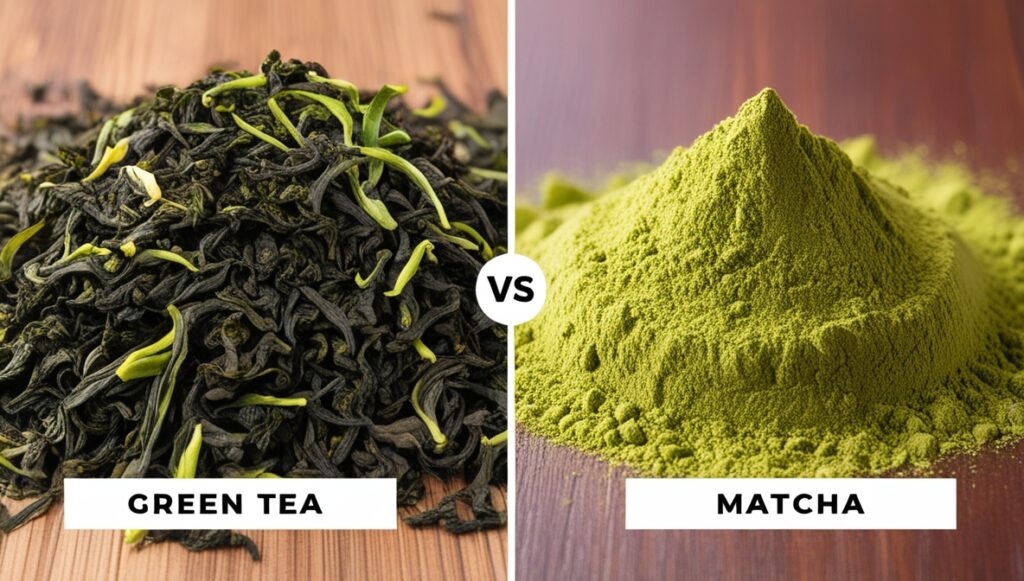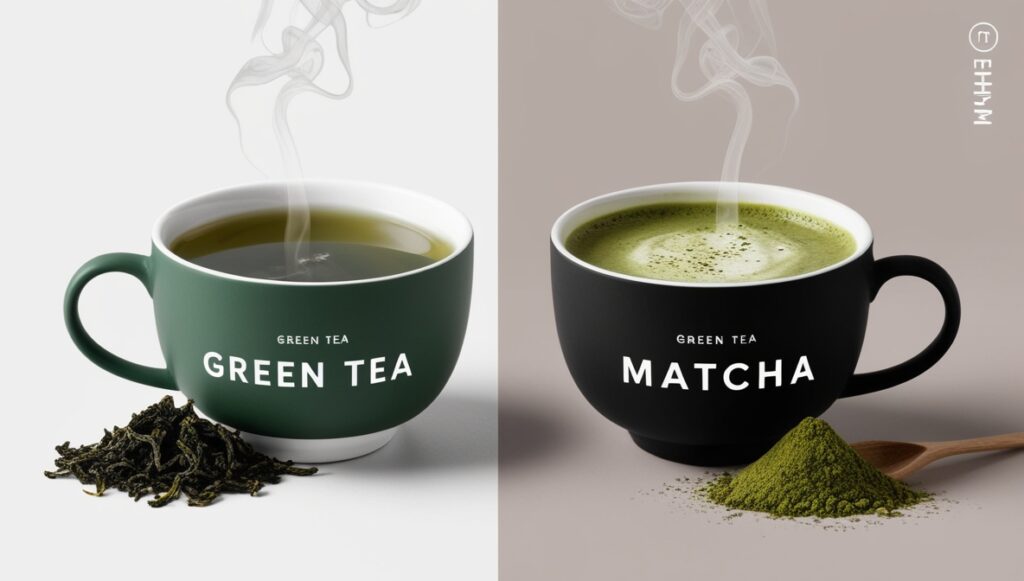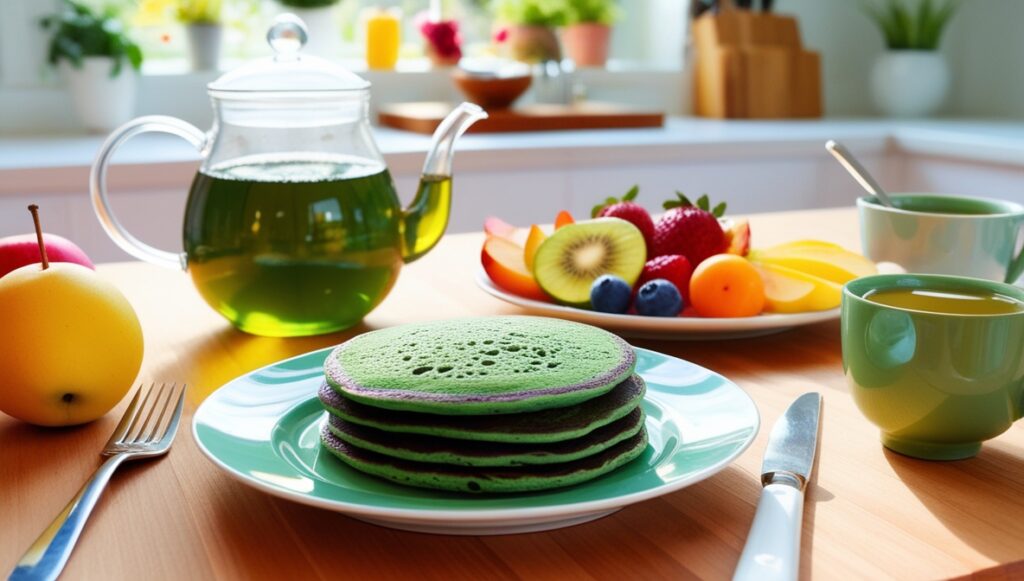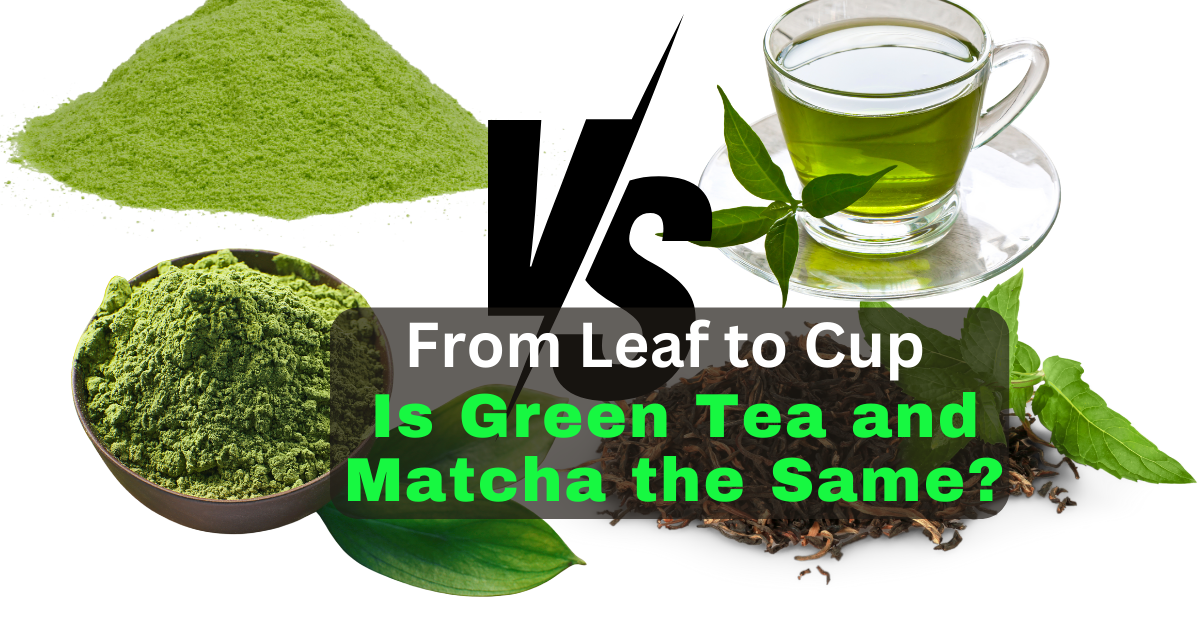Popular drinks like matcha and green tea are frequently praised for their health advantages, however many people wonder, “Is green tea and matcha the same?” Even if they are somewhat similar, they are also very different from one another. To assist you learn more about these two well-liked drinks, we’ll go into great detail regarding their differences and similarities in this post.
Table of Contents
What is Green Tea?
One variety of tea produced from the Camellia sinensis plant is called green tea. Green tea is prepared differently from black tea, which has completely oxidised, by gently boiling or pan-frying the leaves, preserving their vibrant green colour and crisp flavour. High concentrations of antioxidants, especially catechins, found in green tea are well-known for their potential health advantages, which may include supporting weight loss and heart health.

What is Matcha?
A particular variety of green tea called matcha is finely powdered. Matcha entails drinking the entire tea leaf, as opposed to ordinary green tea, which involves steeping the leaves in water and discarding them after use. This indicates that when compared to ordinary green tea, matcha has a stronger flavour and more nutrients. Matcha is a vivid green tea that has gained popularity worldwide due to its possible health benefits and usage in traditional Japanese tea ceremonies.
Is Green Tea and Matcha the Same in Terms of Production?
When pondering the question, “Is green tea and matcha the same?,” it is important to take their production methods into account. Despite coming from the same plant, they are grown and processed very differently.
Green Tea Production
To avoid oxidation, green tea leaves are picked, allowed to wither, and then swiftly steamed or pan-fried. After that, the leaves are dried and wrapped to create the popular loose-leaf green tea or tea bags that so many people love.
Matcha Production
Conversely, matcha requires a more involved procedure. Before being harvested, the tea plants used to make matcha are shaded for a few weeks. The vivid green colour of matcha is attributed to an increase in chlorophyll concentration caused by this shading. The leaves are harvested, dried, and then processed into a fine powder by steaming. The end product is a singular tea with a distinct flavour and consistency.
Is Green Tea and Matcha the Same Nutritionally?
When comparing green tea and matcha, another important factor is their nutritional content. Is green tea and matcha the same in terms of health benefits?
Green Tea Nutrition
Antioxidants included in green tea, especially catechins, have been shown to enhance heart health, increase metabolism, and even guard against some forms of cancer. Depending on the kind and brewing period, 20–35 mg of caffeine can be found in a regular cup of green tea.
Matcha Nutrition
Matcha provides a more concentrated nutrient source when the whole leaf is consumed. This indicates that when compared to ordinary green tea, matcha has higher quantities of antioxidants, vitamins, and minerals. Up to 137 times as many antioxidants can be discovered in one serving of matcha as in a typical cup of green tea. With about 70 mg of caffeine per serving, matcha also contains more caffeine than other drinks, giving you a longer-lasting energy boost.
Is Green Tea and Matcha the Same in Taste and Preparation?

The flavor and preparation methods for green tea and matcha also differ significantly.
Green Tea Taste and Preparation
The flavour of green tea is crisp, light, and vaguely grassy. Usually, the leaves are steeped in hot water for a few minutes before being brewed. Depending on the variety of green tea, the precise brewing temperature and duration can change, but the end product is typically a delicate and reviving drink.
Matcha Taste and Preparation
When it comes to flavour, matcha is more potent and richer than ordinary green tea. It tastes rather vegetal and sweet with a trace of bitterness. Matcha powder is made into froth by whisking it with hot water with a bamboo whisk. When green tea is prepared this way, the resulting texture is distinct and creamy, unlike the clear liquid.
Is Green Tea and Matcha the Same in Terms of Culinary Uses?
Another interesting aspect to explore is the culinary uses of green tea and matcha. Is green tea and matcha the same in their versatility in cooking and baking?
Green Tea in Cooking
In addition to being consumed as a drink, green tea has culinary and baking applications. Green tea leaves can be used to flavour soups, sauces, and desserts in a delicate way. They can also be ground into a powder and added to liquids.
Matcha in Cooking
In the culinary arts, matcha is extremely adaptable. Its powdered form facilitates its easy integration into a variety of recipes. Everything from cakes and cookies to smoothies and lattes can benefit from the flavour and colour of matcha. Both chefs and family cooks adore it for its distinctive flavour and vivid colour.
Is Green Tea and Matcha the Same in Popularity and Cultural Significance?
When considering the question, “Is green tea and matcha the same?” it’s also worth noting their cultural significance and popularity around the world.
Green Tea Popularity
People have been drinking green tea for millennia, especially in East Asian countries like China and Japan. It is frequently connected to a number of customs and rituals. Green tea’s health benefits and refreshing flavour have made it increasingly popular around the world in recent years.
Matcha Popularity
Matcha has been used in Japanese tea ceremonies for a very long time, and its popularity has recently increased worldwide. It has become a popular ingredient in cafés, restaurants, and homes all over the world because of its vivid colour, distinctive cooking technique, and possible health advantages.
Is Green Tea and Matcha the Same in Terms of Health Benefits?
Although matcha and green tea are both celebrated for their health advantages, are these advantages the same for each?

Green Tea Health Benefits
Green tea is well-known for its ability to promote weight loss, enhance cognitive function, reduce the risk of heart disease, and serve as a source of antioxidants that may offer some protection against a number of diseases. It is a well-liked option for people who want to cut back on their caffeine intake without sacrificing a boost to energy and focus due to its comparatively low caffeine content.
Matcha Health Benefits
Because matcha is concentrated, it has even more health advantages than ordinary green tea. Due to matcha’s higher antioxidant content, it can lessen inflammation, fight free radicals, and promote general health. Because matcha contains more caffeine than coffee, it gives you a longer-lasting energy boost without giving you the jitters.
Related: Best Green Tea for Weight Loss
Conclusion: Is Green Tea and Matcha the Same?
In conclusion, matcha and green tea are not the same, despite certain similarities between them. Each is distinct due to variations in manufacturing methods, flavour, preparation methods, nutritional value, culinary applications, and cultural importance. Whether you like matcha’s rich, potent flavour or green tea’s light, refreshing flavour, both have several health advantages and may be consumed in different ways. Thus, when someone queries this again, “Is green tea and matcha the same?” Although they originate from the same plant, you’ll notice that they differ in a lot of delightful ways.
For more visit nutrifyboost

